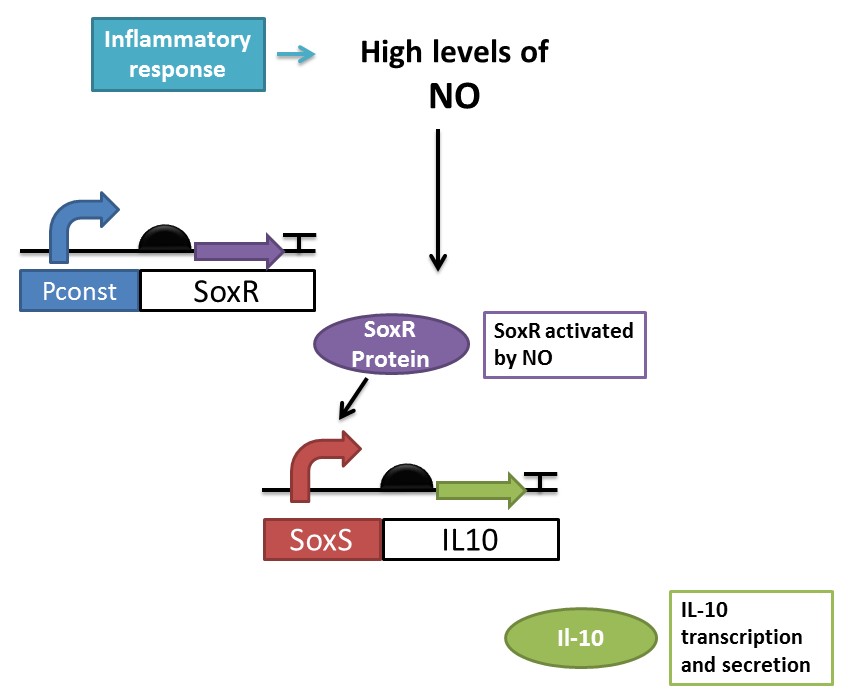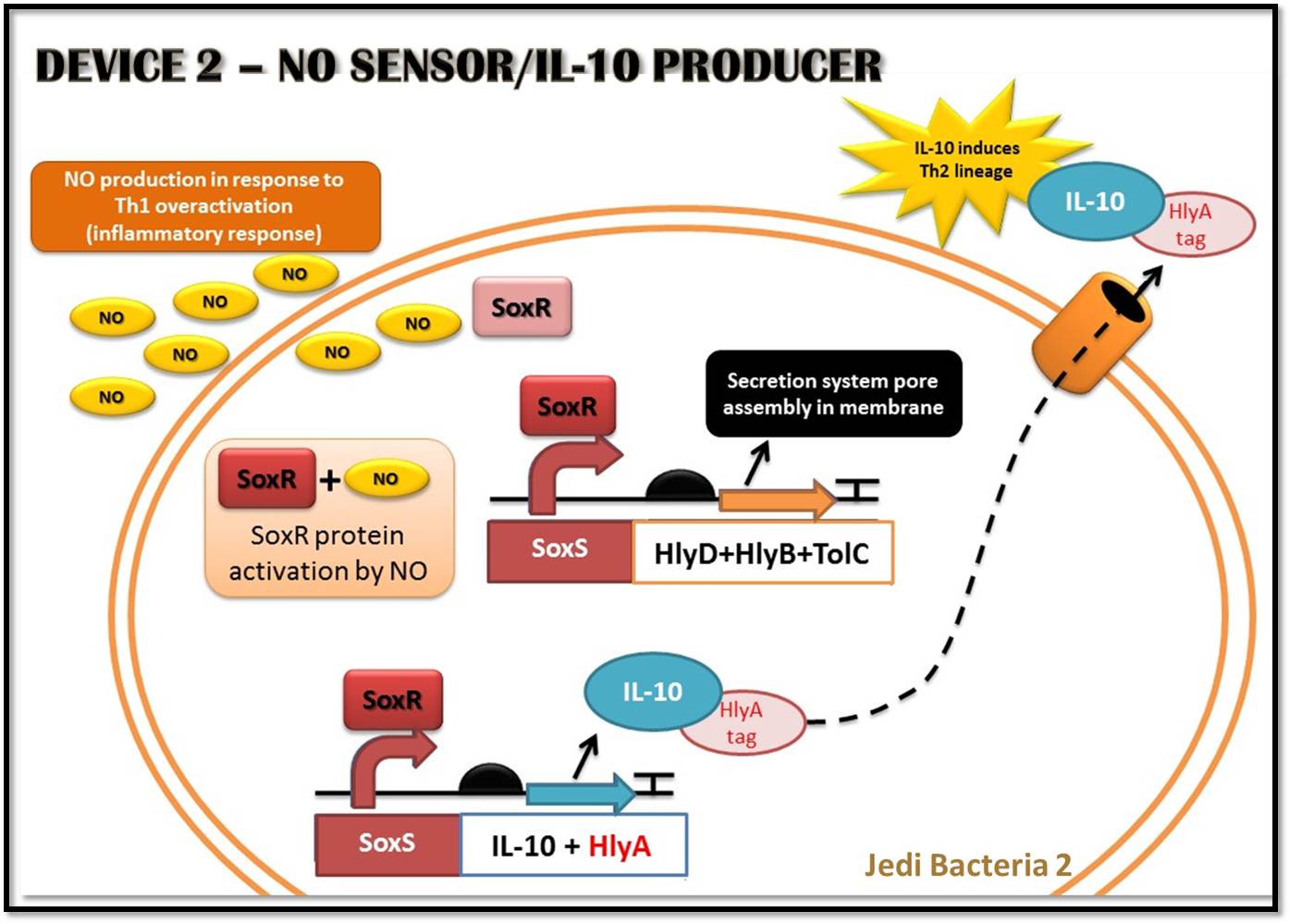Part:BBa_K554004
IL10
IL-10 is an anti-inflammatory interleukin, produced mainly by monocytes. It is responsible for down-regulating the synthesis of pro-inflammatory cytokines like IFN-γ, IL-2, IL-3, TNFα (Th1 cytokines), class II MHC, and co-stimulatory molecules on macrophages. IL-10 also displays potent abilities to suppress the antigen presentation capacity of APCs (Antigen Presenting Cells), and it is also responsible for enhancing B cell survival, proliferation and antibody secretion. In this scenario IL-10 favors Th2 response (Elenkov & Chrousos, 1999).
Some studies suggested that IL-10 acts as immunoregulator in intestinal tract. For example Steidler et al (2000) used a genetically modified Lactococcus lacti expressing IL-10 to treat mice with Inflammatory Bowel Disease (IBD), and the inflammatory response signals were reduced in 50%. IBD is an autoimmune disease which, unlike the immune response found in intestinal tract due to stress, involves a Th1 polarization and inflammation.
Sequence and Features
- 10COMPATIBLE WITH RFC[10]
- 12COMPATIBLE WITH RFC[12]
- 21COMPATIBLE WITH RFC[21]
- 23COMPATIBLE WITH RFC[23]
- 25COMPATIBLE WITH RFC[25]
- 1000COMPATIBLE WITH RFC[1000]
Usage and Biology
This part is used by [http://2011.igem.org/Team:UNICAMP-EMSE_Brazil UNICAMP-EMSE Brazil team] as the final product of the [http://2011.igem.org/Team:UNICAMP-EMSE_Brazil/Project#Device_2:_NO_sensor.2FIL-10_producer NO sensor device/ IL-10 producer] ("Device 2", which senses NO levels and responds by producing and secreting IL-10. This part is shown as green in the following schema:
The team chooses IL-10 to impair inflammatory response mediated by Th1 overstimulation (due to Device 1 action), to reach an equilibrium between immune stimulation (Th1) and suppression (Th2).
In the folllowing schema you can have a more detailed view of the [http://2011.igem.org/Team:UNICAMP-EMSE_Brazil/Project#Device_2:_NO_sensor.2FIL-10_producer NO sensor device/ IL-10 producer] ("Device 2") functioning:
Three-dimensional structure representation
You can find below a tridimensional structure of Homo sapiens IL-10 protein (retrieved from PDB 2h24, Yoon et al. 2006), solved by X-Ray crystallography at 2.0Å. This is a jmol applet, in which you can interactively see the protein format:
MIT_MAHE 2020
Usage and Biology
IL-10 is a major immune-regulatory cytokine that acts on many cells of the immune system where it has profound anti-inflammatory functions, limiting excessive tissue disruption caused by inflammation. It is responsible for down-regulating the synthesis of pro-inflammatory cytokines like IFN-γ, IL-2, IL-3, TNFα (Th1 cytokines). IL-10 even displays potent abilities to suppress the antigen presentation capacity of APCs (Antigen Presenting Cells) such as macrophages and monocytes and inhibits their release of pro-inflammatory cytokines including granulocyte-macrophage colony-stimulating factor/ GM-CSF, granulocyte colony-stimulating factor/ G-CSF, IL-1 beta, IL-6, IL-8, and TNF-alpha (R de Waal Malefyt et al., 1991) (F. Willems et al., 1994) (S. I. Hashimoto et al., 2001). It also interferes with antigen presentation by reducing the expression of MHC-class II and co-stimulatory molecules, thereby inhibiting their ability to induce T-cell activation (K. Frei et al., 1994). IL-10 is also responsible for enhancing B cell survival, proliferation, and antibody secretion.
Some studies suggested that IL-10 acts as an immunoregulator in the intestinal tract. For example, Steidler et al., 2000, used a genetically modified Lactococcus lacti expressing IL-10 to treat mice with Inflammatory Bowel Disease (IBD), and the inflammatory response signals were reduced by 50%.
Human IL-10 (hIL-10) has been shown to exist in solution predominantly as a homodimer, composed of two polypeptide chains of 160 amino acids each. The subunits within the dimer are non-covalently associated, although each subunit contains two intra-chain disulfide bonds, between residues 12 and 108, and between residues 62 and 114. On the basis of its high helical content and limited sequence similarity, it has been postulated that IL-10 is a member of a large family of helical cytokines and growth factors, many of which have been characterized structurally (A. Zdanov et al., 1995).
Over time the IL-10's function has emerged as the treatment of tumor-bearing mice has been shown to inhibit tumor metastasis (L.M. Zheng et al., 1996). Additional investigation by multiple laboratories has generated data that further supports IL-10's immunostimulatory capacity in an immunoncology context. Expression of IL-10 from transfected tumor cell lines in IL-10 transgenic mice or dosing with IL-10 leads to control of primary tumor growth and decreased metastatic burden (S. Fujii et al., 2001) (R.M. Berman et al., 1996).
References
Steidler L, Hans W, Schotte L, Neirynck S, Obermeier F, Falk W, Fiers W, Remaut E. Treatment of murine colitis by Lactococcus lactis secreting interleukin-10, Science 289. 2000. 1352–1355. [http://www.ncbi.nlm.nih.gov/pubmed/10958782 Link to Pubmed]
Yoon, S.I., Logsdon, N.J., Sheikh, F., Donnelly, R.P., Walter, M.R. Conformational changes mediate interleukin-10 receptor 2 (IL-10R2) binding to IL-10 and assembly of the signaling complex. Journal: (2006) J.Biol.Chem. 281: 35088-35096 [http://www.ncbi.nlm.nih.gov/entrez/query.fcgi?cmd=Retrieve&db=PubMed&dopt=Abstract&list_uids=16982608 Link to PubMed]
Elenkov IJ, Chrousos GP. Stress Hormones, Th1/Th2 patterns, Pro/Anti-inflammatory Cytokines and Susceptibility to Disease. Trends Endocrinol Metab. 1999 Nov;10(9):359-368. [http://www.ncbi.nlm.nih.gov/pubmed/10511695 Link to Pubmed ]
de Waal Malefyt, R., Abrams, J., Bennett, B., Figdor, C. G., & de Vries, J. E. (1991). Interleukin 10(IL-10) inhibits cytokine synthesis by human monocytes: an autoregulatory role of IL-10 produced by monocytes. The Journal of experimental medicine, 174(5), 1209–1220. https://doi.org/10.1084/jem.174.5.1209
Willems, F., Marchant, A., Delville, J. P., Gérard, C., Delvaux, A., Velu, T., de Boer, M., & Goldman, M. (1994). Interleukin-10 inhibits B7 and intercellular adhesion molecule-1 expression on human monocytes. European journal of immunology, 24(4), 1007–1009. https://doi.org/10.1002/eji.1830240435
Hashimoto, S. I., Komuro, I., Yamada, M., & Akagawa, K. S. (2001). IL-10 inhibits granulocyte-macrophage colony-stimulating factor-dependent human monocyte survival at the early stage of the culture and inhibits the generation of macrophages. Journal of immunology (Baltimore, Md.: 1950), 167(7), 3619–3625. https://doi.org/10.4049/jimmunol.167.7.3619
Frei, K., Lins, H., Schwerdel, C., & Fontana, A. (1994). Antigen presentation in the central nervous system. The inhibitory effect of IL-10 on MHC class II expression and production of cytokines depends on the inducing signals and the type of cell analyzed. Journal of immunology (Baltimore, Md.: 1950), 152(6), 2720–2728.
Zdanov, A., Schalk-Hihi, C., Gustchina, A., Tsang, M., Weatherbee, J., & Wlodawer, A. (1995). Crystal structure of interleukin-10 reveals the functional dimer with an unexpected topological similarity to interferon gamma. Structure (London, England: 1993), 3(6), 591–601. https://doi.org/10.1016/s0969-2126(01)00193-9
Zheng, L. M., Ojcius, D. M., Garaud, F., Roth, C., Maxwell, E., Li, Z., Rong, H., Chen, J., Wang, X. Y., Catino, J. J., & King, I. (1996). Interleukin-10 inhibits tumor metastasis through an NK cell-dependent mechanism. The Journal of experimental medicine, 184(2), 579–584. https://doi.org/10.1084/jem.184.2.579
Fujii, S., Shimizu, K., Shimizu, T., & Lotze, M. T. (2001). Interleukin-10 promotes the maintenance of antitumor CD8(+) T-cell effector function in situ. Blood, 98(7), 2143–2151. https://doi.org/10.1182/blood.v98.7.2143
Berman, R. M., Suzuki, T., Tahara, H., Robbins, P. D., Narula, S. K., & Lotze, M. T. (1996). Systemic administration of cellular IL-10 induces an effective, specific, and long-lived immune response against established tumors in mice. Journal of immunology (Baltimore, Md.: 1950), 157(1), 231–238.| None |


